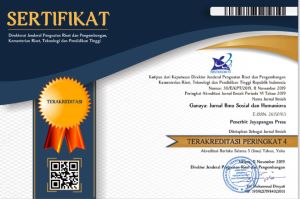Toponimi Kampung di Sepanjang Sungai Cimande Sebagai Basis Mitigasi Bencana Hidrologi
DOI:
https://doi.org/10.37329/ganaya.v8i3.4583Keywords:
Toponymy, Cimande River, Disaster Mitigation, Anthropolinguistics, Local WisdomAbstract
Villages along the Cimande River are prone to hydrogeological disasters, such as floods and landslides, and have become increasingly densely populated with residential and industrial areas. Toponymic research in this area reveals local knowledge about river hydrology dynamics and can inform culture-based disaster mitigation strategies. This study examines the structure and meaning of village toponymy along the Cimande River, analyzes its correlation with hydrogeological disaster vulnerability, and formulates a mitigation model based on local wisdom. This study employs a qualitative approach with an anthropological focus, collecting data through in-depth interviews, observations, and documentation studies. Informants were purposely selected from among traditional leaders with knowledge of local history. The results show that village toponymy in this region contains many geographical and hydrological elements. For example, the word Leuwi "pool or inner part of a river," Parakan "swamp; place to catch fish," and Ranca "swamp," indicating flood-prone areas. Conversely, villages with names referring to high areas, such as Pasir ("hill"), Lamping ("sloping land"), Nendeut ("landslide"), and Manggung ("higher place/area"), have lower vulnerability to flooding but higher vulnerability to landslides. These toponyms' meanings correlate with the level of disaster vulnerability in the Cimande watershed area, making them useful local indicators for mitigation. These findings emphasize the importance of utilizing toponymy as a source of information and as the basis for developing a hydro-meteorological disaster mitigation model rooted in local wisdom. This model could be used by policymakers, particularly the Sumedang Regency Government, to integrate traditional knowledge into spatial planning, education, and community outreach.
References
Darmawan, W., Mulyana, A., & Kurniawati, Y. (2022). Study Of Local Wisdom Based On Disaster Mitigation In The Community Of Traditional Villages In West Java As Materials In History Learning. Historia: Jurnal Pendidik Dan Peneliti Sejarah, 5(1), 21-26.
Erikha, F., Ninie Susanti, Kresno Yulianto. (2018). Modul Toponimi. Jakarta: Direktorat Sejarah Kementerian Pendidikan dan Kebudayaan.
Faccini, F, Hearn R.A, Pedemonte S, Saccini A. (2017). Geo-Hydrological Hazard Underlined by Toponymy of Italian Military Geographycal Institute Maps at 1:25,000 scale. Contributions to the Knowledge of Floodplain and Hillslope Dinamycs. Proceeding 6th EUGEO. Brussels, Belgium.
Fadillah, A. (2019). Kajian Peningkatan Kapasitas Sungai Cimande sebagai Pengendali Banjir Wilayah Rancaekek Kabupaten Bandung Kabupaten Sumedang. (Doctoral dissertation, Institut Teknologi Nasional Bandung).
Handiana, D. (2014). Nama-nama Tempat di Kecamatan Cimanggung Kabupaten Sumedang: Kajian Struktur dan Makna. Bandung: Universitas Padjadjaran.
Hidayat, A.R, et.al. (2023). Penyuluhan Bahaya dan Upaya Mitigasi Bencana Hidrometeorologi di Desa Lembah Sari, Kecamatan Batu Layar, Kabupaten Lombok. Rengganis: Jurnal Pengabdian Masyarakat, 3(2), 179-186.
Hisyam, F, Sabila W.I. (2020). Kajian Toponimi Kampung di Sepanjang Sungai Brantas, Kota Malang: Suatu Upaya Mitigasi Bencana Hidrologi. J Dialog Penanggulangan Bencana, 11(2):155 – 166.
Ibrahim, A.S, Susanto G, Taufiqurrahman F. (2021). Antropologi Linguistik. Bandung: Refika Aditama.
Kabupaten Sumedang Jawa Barat. (2018). Peraturan Daerah Kabupaten Sumedang Nomor 4 Tahun 2018 tentang Rencana Tata Ruang Wilayah Kabupaten Sumedang tahun 2018-2038.
Lestari, A.A. (2024). Toponimi Nama Desa di Wilayah Sungai Bahar Kabupaten Muaro Jambi. Jambi: Universitas Jambi.
Maliki, R.Z, Abd Muis A, Khairurraziq K. (2022). Mitigasi Bencana Berbasis Kearifan Lokal Masyarakat Desa Tompe Kabupaten Donggala. Geodika: Jurnal Kajian Ilmu dan Pendidikan Geografi, Desember 316(2):254-63.
Pratiwi, A. E., Triyono, S., Rezkiyanto, I., Asad, A. S., & Khollimah, D. A. (2018). Eksistensi Masyarakat Adat di Tengah Globalisasi. Jurnal Civics: Media Kajian Kewarganegaraan, 15 (2), 95-102.
Pratiwi, B., & Hartati, R. D. (2024). Penamaan Perumahan di Jalan Ciputat-Parung: Kajian Toponimi. Bahasa: Jurnal Keilmuan Pendidikan Bahasa dan Sastra Indonesia, 6(1), 12-21.
Rahman, K.S, Kamal M.M. (2014). Local Wisdom: Indigenous Practices for Mitigating Disaster Loss. Project Report.
Sibarani, R. (2004). Antropolinguistik: Antropologi Linguistik – Linguistik Antropologi. Medan: Poda.
Sibarani, R. (2015). Pendekatan Antropolinguistik terhadap Kajian Tradisi Lisan. RETORIKA: Jurnal Ilmu Bahasa, 1(1), 1-17.
Sobarna, C, Afsari A.S, Aras T.S. (2020). Jejak Sunda di Jawa Tengah: Sebuah Penelusuran Toponimi. Bandung: Unpad Press.
Sobarna, C., Gunardi, G., & Afsari, A. S. (2019, December). Penguatan Karakter Melalui Kajian Toponimi. In Prosiding Seminar Nasional LP3M (Vol. 1, pp. 83-88).
Sugiyono. (2012). Metode Penelitian Kuantitatif Kualitatif dan R&D. Bandung: Alfabeta.
Syafii, A. M., & Kosasih, D. (2020). Antropolinguistik dalam Toponimi Kabupaten Subang. LOKABASA, 15(2), 210-221.
Yotsumoto, Y. (2020) Place Names and Natural Disasters in Japan. Handbook of the Changing World Language Map, 2157-2172.
Yustiana, F., Ridwanullah, M. H., Kurniadi, Y. N., Wardhani, E., & Widyaningsih, E. (2024). HEC-RAS Model For Drainage Capacity Analysis And Peak Discharge Simulation Of Cimande River. GEOMATE Journal, 27(123), 30-37.
Downloads
Published
How to Cite
Issue
Section
License
Copyright (c) 2025 Taufik Setyadi Aras, Dadi Suhanda (Author)

This work is licensed under a Creative Commons Attribution-ShareAlike 4.0 International License.
An author who publishes in the Ganaya : Jurnal Ilmu Sosial dan Humaniora agrees to the following terms:
- Author retains the copyright and grants the journal the right of first publication of the work simultaneously licensed under the Creative Commons Attribution-ShareAlike 4.0 License that allows others to share the work with an acknowledgement of the work's authorship and initial publication in this journal
- Author is able to enter into separate, additional contractual arrangements for the non-exclusive distribution of the journal's published version of the work (e.g., post it to an institutional repository or publish it in a book) with the acknowledgement of its initial publication in this journal.
- Author is permitted and encouraged to post his/her work online (e.g., in institutional repositories or on their website) prior to and during the submission process, as it can lead to productive exchanges, as well as earlier and greater citation of the published work (See The Effect of Open Access).
Read more about the Creative Commons Attribution-ShareAlike 4.0 Licence here: https://creativecommons.org/licenses/by-sa/4.0/.








